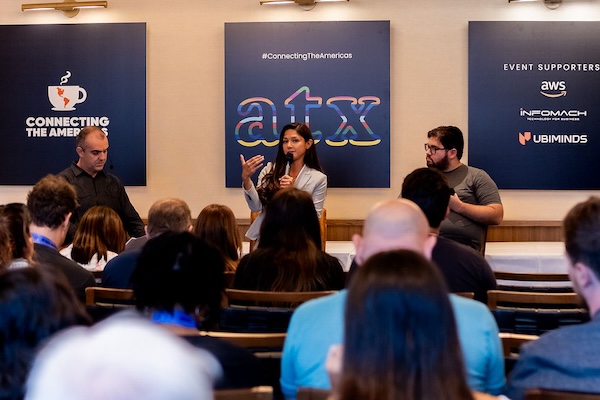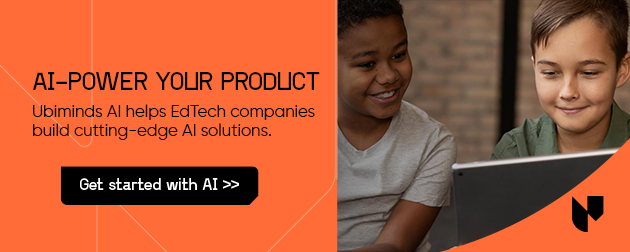Artificial Intelligence has been disrupting all kinds of industries. But how will it impact our daily lives? Here, we share the key discoveries during Connecting the Americas’ “Applying AI to Education” fireside chat. Read on to delve into the transformative potential of AI in revolutionizing the teaching and learning landscape.
In this insightful discussion, we’re fortunate to hear from three distinguished voices in the field:
- Alberto Silveira, Co-Creator of Connecting the Americas and CTO
- Alyssa Lee, Senior GTM , Customer Success (AI/ML) at AWS
- Pedro Ferreira, Head of AI at Ubiminds and Snowfox

Alberto Silveira (Co-Creator of Connecting the Americas), Alyssa Lee (Senior GTM , Customer Success (AI/ML) at AWS), and Pedro Ferreira (Head of AI at Ubiminds)
Ready? Let’s explore how it can enhance educational experiences and foster greater engagement and outcomes for learners worldwide! You can either watch the full session below, or read our article on the key learnings.
Definition and Basics of Artificial Intelligence Applied to Education
We kick things off by defining artificial intelligence.
Artificial intelligence (AI) encompasses various subsets, including machine learning and deep learning, with applications ranging from everyday devices like microwaves to complex systems like self-driving cars.
There are various subsets, including machine learning and deep learning. Understanding these concepts lays the foundation for comprehending AI’s role in education (explored in the next section).
To begin with, key definitions to have in mind:
- Artificial Intelligence: AI is a program that encompasses various subsets, including machine learning and deep learning, designed to mimic human intelligence and automate tasks.
- Machine Learning: AI subset focused on algorithms that enable systems to learn from data, identify patterns, and make decisions with minimal human intervention.
- Deep Learning: Advanced AI technique inspired by the structure and function of the human brain, involving neural networks to process data and learn complex patterns.
- Automation in Education: AI serves as a tool for automating tasks in education, enhancing efficiency, and facilitating personalized learning experiences.
- AI in Education Use Cases: Includes chatbots for student support, adaptive learning systems, personalized tutoring, and data-driven decision-making for educators.
- Challenges and Risks: Concerns such as data quality, algorithmic bias, and the potential for AI models to generate inaccurate information (hallucinations) pose challenges that must be addressed in AI-driven educational initiatives.
Leveraging AI for Teaching and Learning
In the context of education, AI serves as a form of automation, simplifying tasks for educational organizations, educators, and learners alike. It:
- Streamlines administrative processes
- Facilitates personalized learning experiences
- Optimizes lesson planning
- Identifies at-risk students
…and other activities. Ultimately, it enhances the efficiency and effectiveness of teaching and learning processes. By automating routine tasks and allowing educators to analyze large datasets, it helps teachers and admins to make data-informed decisions.
Three Use Cases and Practical Applications
So how about we examine real-world examples of AI implementation in education? From chatbots aiding student inquiries to personalized learning experiences tailored to individual needs, the possibilities are endless.
#1 Chatbots for Personalized Support
“Chatbots serve as virtual assistants, providing personalized support to students on their learning journey,” explains Pedro.
“These AI-powered bots engage with students in real-time, offering immediate assistance and tailored guidance.”
These chatbots can answer questions, provide feedback, and offer resources tailored to individual needs. By leveraging natural language processing algorithms, chatbots enhance student engagement and facilitate a more interactive learning experience.
#2 Adaptive Learning Platforms
AI-driven adaptive learning platforms analyze student performance data to tailor educational content and activities to each learner’s unique needs and learning pace. Alyssa emphasizes that
“These platforms dynamically adjust learning materials and interventions based on individual performance data, promoting personalized learning experiences.”
Platforms can adjust the difficulty level of tasks, provide customized learning pathways, and offer targeted interventions to address areas of weakness. By personalizing the learning experience, adaptive learning platforms optimize student outcomes and promote academic success.
#3 Early Intervention Systems
AI-based early intervention systems identify at-risk students by analyzing various indicators, such as academic performance, behavior patterns, and engagement levels.
“By analyzing academic performance, behavior patterns, and engagement levels, these systems empower educators to intervene early and address student needs effectively.“, Alberto reminds us.
These systems proactively flag students who may be struggling or at risk of falling behind, enabling educators to intervene and provide targeted support. By identifying potential challenges before they escalate, early intervention systems empower educators to address student needs effectively and foster academic success.

How to Address Challenges and Risks Posed by AI Use in Education
Despite its immense potential, AI in education also presents challenges and risks, such as the phenomenon of “hallucination” where AI models generate inaccurate or misleading information. We explore strategies to mitigate these risks and ensure responsible AI use in educational settings.
1. Ensuring Ethical and Responsible AI Use
Ethical considerations are paramount when integrating AI into education. “Educational institutions must establish clear guidelines and frameworks to ensure ethical and responsible AI use.”, Pedro explains.
Key Points:
- Establish ethical guidelines for AI development and deployment.
- Implement transparency measures to ensure accountability.
- Provide training and awareness programs for educators and stakeholders on ethical AI use.
2. Ensuring Data Privacy and Security
Alyssa highlights the importance of data privacy in AI-driven educational systems. “Protecting student data is crucial to maintain trust and integrity,” she states.
Key Points:
- Implement robust data privacy policies and security measures.
- Ensure compliance with regulations such as GDPR and COPPA.
- Educate stakeholders on data privacy rights and best practices.
3. Addressing Bias and Fairness
“AI algorithms must be rigorously tested and monitored to detect and address bias,” advises Alberto. After all, fairness and equity should be central to AI development in education.
Key Points:
- Conduct bias assessments and algorithm audits regularly.
- Employ diverse datasets and inclusive design principles.
- Implement mechanisms for feedback and bias correction.
4. Promoting Transparency and Explainability
“Transparency and explainability are essential for building trust in AI systems,” states Pedro. Educators and students should understand how AI algorithms work and the rationale behind their decisions.
Key Points:
- Provide clear explanations of AI algorithms and processes.
- Foster open communication channels for feedback and inquiries.
- Ensure transparency in decision-making processes involving AI.
5. Fostering Digital Literacy and Awareness
Digital literacy is vital for navigating the complexities of AI-powered technologies. “Educational programs should focus on empowering students with critical thinking and digital skills.”, Alyssa emphasizes.
Key Points:
- Integrate digital literacy and AI education into the curriculum.
- Offer training and professional development for educators on AI literacy.
- Promote awareness of AI’s societal impacts and ethical implications.
6. Collaborating and Sharing Best Practices
Alberto stresses the importance of collaboration and knowledge sharing in addressing AI challenges. “Educational institutions should collaborate and share best practices to foster innovation and collective learning,” he suggests.
Key Points:
- Establish communities of practice for AI in education.
- Encourage collaboration between academia, industry, and government.
- Share case studies, resources, and lessons learned to drive continuous improvement.
In conclusion, we reflect on the transformative power of AI in education and the imperative of leveraging this technology responsibly to maximize its benefits while minimizing risks.
Want to Continue Future-gazing?
Interested in delving deeper into the intersection of AI and education? If you found this exploration of AI’s impact on education thought-provoking, we invite you to explore more insights from our series of discussions on AI in education in our EdTech blog section.
You should also check out our other summaries from the Connecting the Americas fireside chats here and here.
Sign up below to receive notifications about upcoming sessions and stay updated on the latest developments in software industry. Don’t miss out on the opportunity to expand your knowledge and connect with industry leaders in the field!
What You Should Know About our Community

International Marketing Leader, specialized in tech. Proud to have built marketing and business generation structures for some of the fastest-growing SaaS companies on both sides of the Atlantic (UK, DACH, Iberia, LatAm, and NorthAm). Big fan of motherhood, world music, marketing, and backpacking. A little bit nerdy too!





